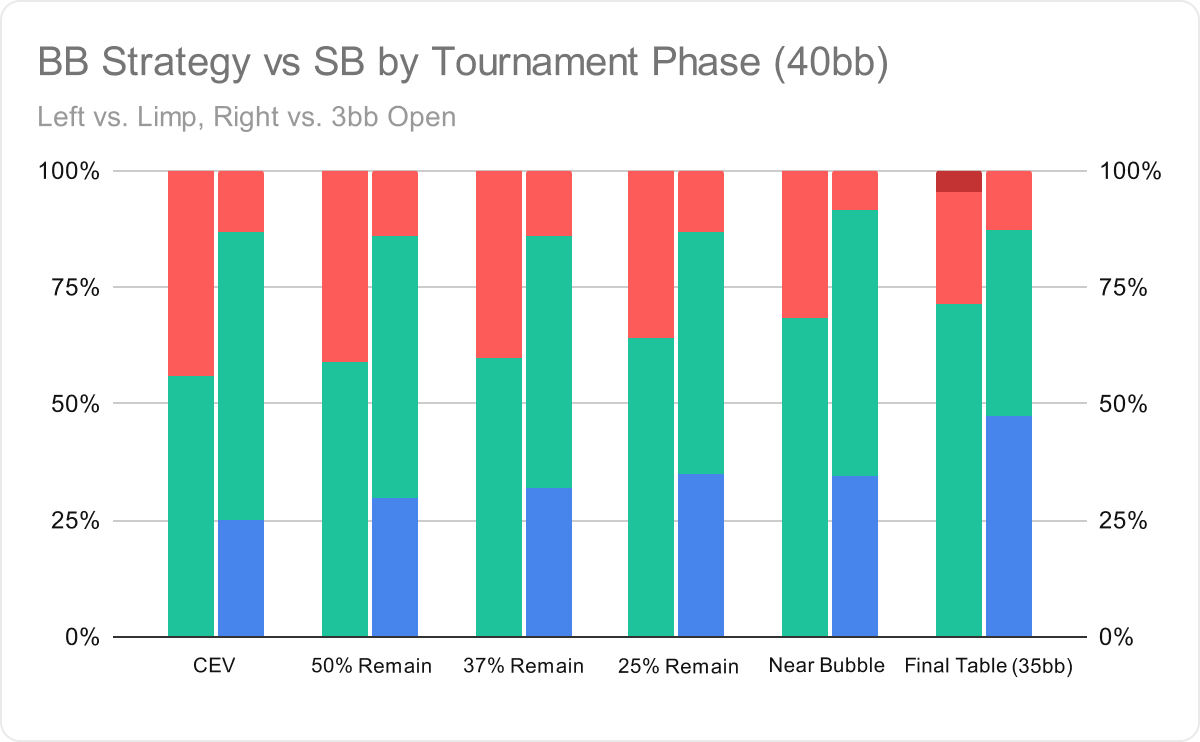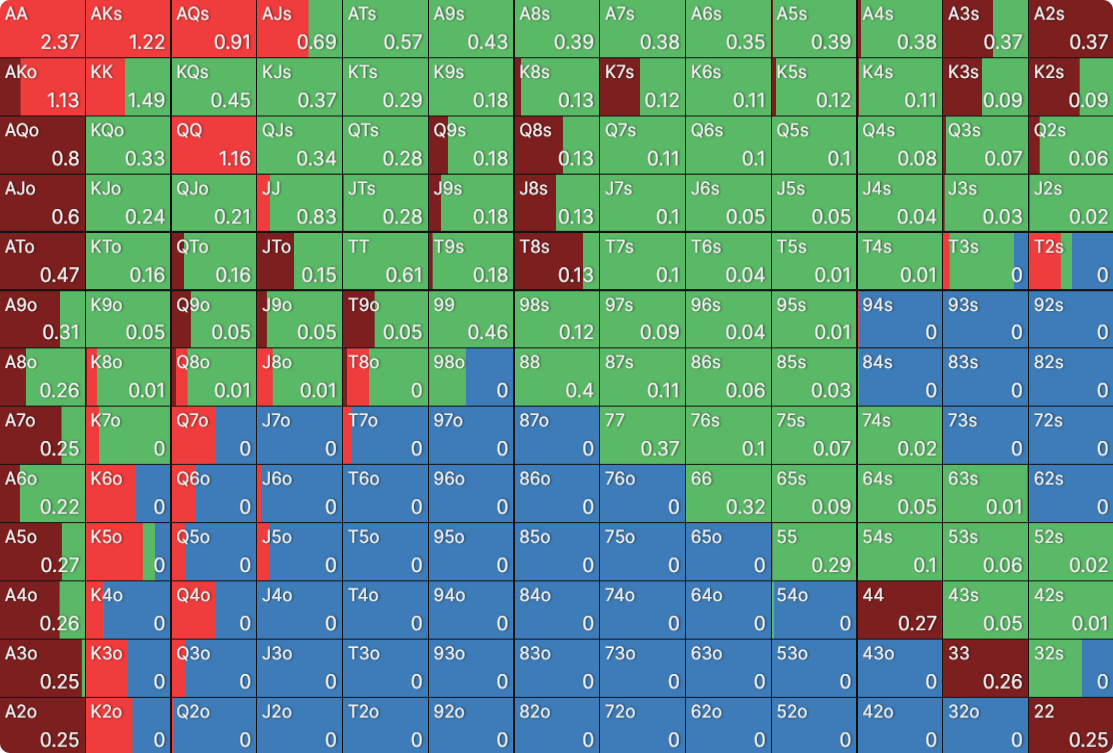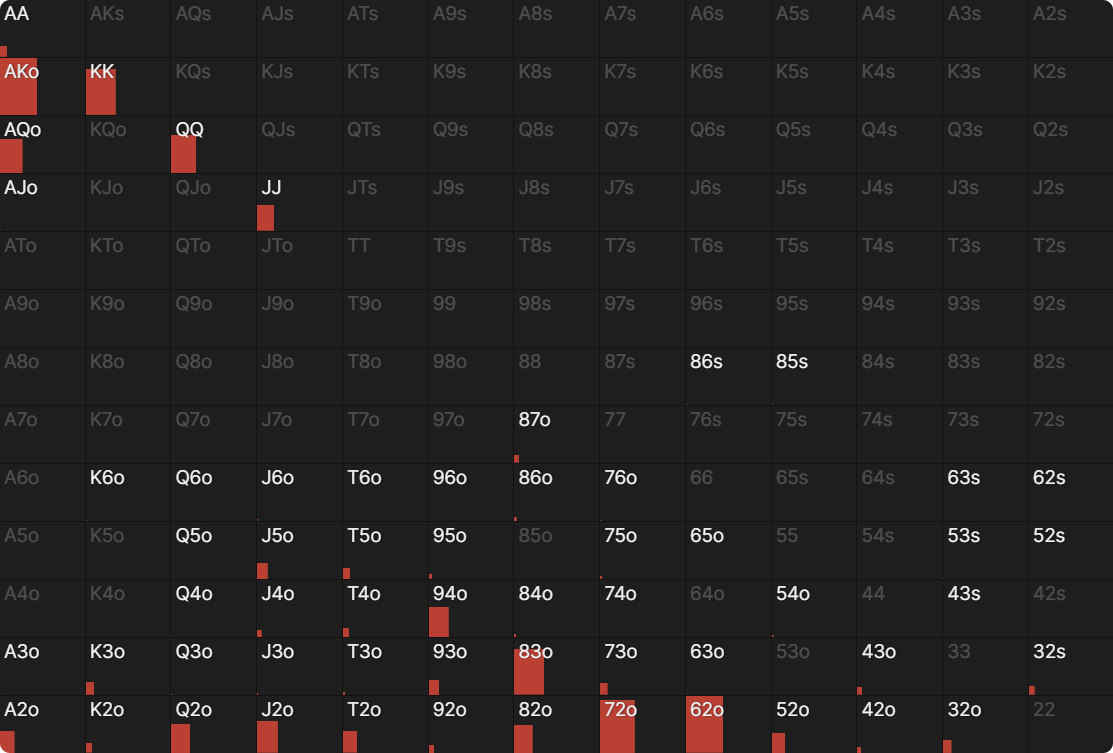ICM and Blind Battles:
The Big Blind
This is a companion piece to this article on the SB’s strategy for blind vs blind play under ICM pressure. In that piece, we saw that, though ICM incentivizes both players to avoid big confrontations, the BB has more leeway to grow the pot on early streets. Their position enables them to bluff, control the size of the pot, and realize equity more effectively than the SB, making it less dangerous for them to start growing the pot pre-flop.
Though ICM incentivizes both players to avoid big confrontations, the BB has more leeway to grow the pot on early streets.
The following chart shows the BB’s strategy for responding to both a limp and a raise from the SB at various stages of a tournament. All these simulations were run with 40bb symmetric stacks, meaning all players have the same stack size. Note that the final table solution was run for 35bb.
Although the BB raises less aggressively as their risk premium mounts, they retain a robust raising range even under the most intense ICM pressure. At this stack depth, raising is simply less dangerous for the BB. Re-raising from out of position is extremely risky for the SB, so the BB can mostly expect to see a flop and continue exercising their positional advantage even if the SB does not fold immediately.
BB’s response to a raise appears not to change so dramatically as the tournament progresses, but this is deceptive. As the risk premium increases, SB’s raising range gets stronger, yet BB’s raising and calling frequencies tighten only slightly. This implies that BB contests the pot with weaker hands relative to the SB’s range as the risk premium increases. The higher the risk premium, the more valuable the BB’s positional advantage, increasing their equity realization.
The higher the risk premium, the more valuable the BB’s positional advantage, increasing their equity realization.
Shallower Stacks
With 20bb stacks, we see a clearer pattern of the BB playing more conservatively as risk premiums increase. This reflects not only their own increased risk, but also the SB’s stronger limping and raising ranges. BB can re-raise more effectively at this stack depth, as the re-raise is now primarily a shove that denies SB the opportunity to move all-in themselves and put BB to an existential decision.
When ICM pressure is most extreme, there is even room for BB to develop a range for three-betting less than all-in. Despite the small size, this raise is extremely polar, as the SB responds almost exclusively by shoving or folding. Contesting a large pot post-flop from out of position is simply too risky a proposition on the bubble or at the final table; any hand good enough for the SB to call would be good enough to shove and would value the fold equity that comes along with that.
The following chart shows BB’s response to a 3bb SB open on the final table with 20bb effective stacks. Hands in light red are non all-in 3bets. Notice how BB draws their bluffs from the top of their folding range, hands that are either barely or not quite good enough to call. There’s no sense in wasting a profitable calling hand on a bluff that will rarely see a flop.
There’s no sense in wasting a profitable calling hand on a bluff that will rarely see a flop.
A good rule of thumb for “normal”, low risk premium tournament situations is that if you raise to a size where you’d be getting 2:1 to call a shove (meaning your raise committed roughly ⅓ of the effective stack), then you might as well shove because any hand you raised would be priced in to call the shove anyway.
With a high risk premium, there is more room to fold after committing ⅓ of your stack because the last of your chips are worth so disproportionately more than those you’ve already committed. The large raise enables strong but vulnerable hands to deny equity more effectively while still giving you room to escape with the last of your chips should you be caught in a bluff.
The Big Raise
There was an interesting anomaly in the first chart we looked at – with symmetric 35bb stacks at a nine-handed final table. The BB has a range for raising to 7bb facing a SB limp. This range is actually most robust with 30bb stacks. With 50bb or more, smaller raises suffice, and with 20bb and fewer, shoving over the limp is preferable, as we see in this chart of the BB’s strategy at a nine-handed final table with various symmetric stack sizes.
The composition of this range can be seen most clearly with the 30bb strategy, where BB uses it most often.
- Strong but vulnerable hands drive the range: AKo, AQo, and JJ – KK. Aces prefer a smaller 3bet. AA gains less from denying equity and blocks much of SB’s shoving range. Where AKo is happy to force folds from QTo and 98s and to induce shoves from A5s, AA gains little from the former and blocks the latter. At the final table, even KK benefits from forcing a shove-or-fold response from much of SB’s Ax; AA is a uniquely robust hand.
- At equilibrium, this raise is not especially profitable as a bluff. Thus, BB goes for the 7bb bluff with only their worst hands, those with the least interest in checking and seeing a flop. Many similar hands that raise rarely or never at equilibrium have EVs quite close to that of checking, so the real takeaway here is that, against the right opponent who will limp and/or fold too often, you should consider this large raise with many of your worst hands.
- Hands in the middle, like QJo or 98s, mostly check to avoid exposing themselves to a re-raise, but when they do raise, they use the 3.5bb size, as they perform better against the SB’s wider calling range when using this size.
- This big raise loses appeal with deeper stacks of 50bb or 60bb. Stealing the blinds and antes is worth less, and even the big pocket pairs (besides AA) are not appealing to stack off with if SB calls or three-bets the big raise.
When the BB Covers
In a scenario where the SB has 35bb but the BB has 40bb, the BB’s risk premium is reduced from 12.2% (when stacks were symmetric) to 11.3%, while the SB’s risk premium is slightly increased to 13.1%. The result of this risk advantage is a slightly more aggressive strategy from the BB, who raises to 7bb with 7% of hands (up from 5% with symmetric stacks) and to 3.5bb with 28% of hands (up from 24%).
Facing a raise from the SB, the BB’s response does not look much different than with symmetric stacks: they call 28%, three-bet 14%, and never shove. However, as we have seen before, the SB’s increased risk premium is built into their raising range, so the BB’s response is similar despite the SB having a stronger range.
When the SB Covers
Facing a limp from a 100bb SB, a 35bb BB never uses the 7bb raise. Instead, they have a small shoving range of about 4% of hands. These are not quite the same hands as raised to 7bb with symmetric stacks. When covered, BB’s shoving range relies heavily on blocking calls, with A9o – AQo and A2o comprising the majority of it.
Despite being covered and facing a risk premium of 15.2%, the BB raises to 3.5bb with 29% of hands, more than the 24% they raise with symmetric stacks. This is a response to the covering SB limping a much wider and weaker range. The SB in this scenario almost never folds, and they mostly raise their strong hands. If anything, a combined raising frequency of 34% seems low compared to the SB’s wide and weak limping range.
Conclusion
With symmetric stacks, the BB has just as much interest as the SB in avoiding big confrontations when under ICM pressure. They have an extra tool for doing so, however, which is using their position to control the pot size after the flop. Consequently, it is safer for them to start growing the pot with a pre-flop raise even when covered by the SB at a final table.
At certain stack depths, they have some unconventional options to consider as well, notably a tiny three-bet and a big raise over a limp. Many human players will be unfamiliar with these plays and respond poorly to them, so with a little experimentation, they should yield especially good results.
Author
Andrew Brokos
Andrew Brokos has been a professional poker player, coach, and author for over 15 years. He co-hosts the Thinking Poker Podcast and is the author of the Play Optimal Poker books, among others.

























































































































































































































































